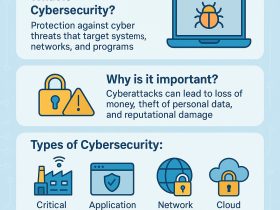Major Cyber Attacks in India: Rising Threats and How to Stay Protected
Cyber attacks have become a growing concern for businesses, governments, and individuals in India. These malicious digital intrusions aim to compromise computer systems, networks, or data for financial gain, espionage, or disruption. As India accelerates its digital transformation, the threat of cybercrime grows more intense, requiring stronger countermeasures and public awareness.
What Are Cyber Attacks?
A cyber attack is an intentional attempt by hackers or cybercriminals to gain unauthorized access to a system, steal sensitive information, or disrupt services. These attacks can range from phishing scams and ransomware to large-scale Distributed Denial of Service (DDoS) attacks and identity theft.
Cyber attackers often use deceptive techniques rather than direct force. They may trick individuals or employees into revealing credentials or unknowingly installing malware—leading to data leaks, financial losses, and reputational damage.
Why Is India a Target for Cybercrime?
India is among the world’s fastest-growing digital economies, with a massive increase in startups, IT services, and online platforms. This rapid digital expansion, while opening doors to innovation and opportunity, also makes India a hot target for cyber threats.
According to recent reports:
- India ranks 4th globally among the most affected countries by cyber attacks.
- Over 70% of Indian organizations face a high risk of cyber threats.
- 35% of companies in the region have reported at least one cyber breach annually.
- 85% of organizations in the Asia-Pacific region lack a solid cybersecurity strategy during digital transformation projects.
With the adoption of technologies like cloud computing, IoT, AI, and machine learning, the attack surface has expanded. Unfortunately, not all businesses are equally prepared.
Common Types of Cyber Attacks in India
Here are some of the most frequent cyber attack methods affecting India:
- Phishing and Email Fraud
- Credit Card and Online Banking Scams
- Malware and Ransomware
- Website Defacement
- Cyberstalking and Harassment
- Hacking of Government Databases
- DDoS (Distributed Denial-of-Service) Attacks
India has witnessed cyber incidents targeting public infrastructure, financial institutions, healthcare databases, and even educational portals. Many of these attacks are traced back to foreign actors or well-organized cybercrime groups.
Prevention & Cybersecurity Best Practices
To protect against the growing tide of cyber threats, individuals and organizations must follow strong cybersecurity practices. Here are essential steps to reduce your risk:
1. Avoid Suspicious Emails and Links
Never open unsolicited emails or click on unknown links. Phishing remains the most common entry point for cybercriminals.
2. Use Only Verified Platforms
Ensure that all transactions—especially banking—are conducted on secure, official websites. Avoid entering personal data on unfamiliar or look-alike domains.
3. Implement Two-Factor Authentication (2FA)
Use 2FA on all critical accounts, including emails, banking apps, and cloud services. It adds an extra layer of security beyond just a password.
4. Strengthen Authentication Systems
Organizations should enhance their login security and implement firewalls, biometric access, and regular access audits.
5. Secure ATM & Digital Payments
Banks must deploy robust encryption and real-time fraud detection for ATMs and online transfers. Encrypted transactions significantly reduce the chances of data interception.
6. Stay Updated with Software Patches
Outdated software can become an easy target. Keep all systems, antivirus programs, and devices updated with the latest security patches.
7. Employee Cybersecurity Training
Companies should educate employees about social engineering, password safety, and secure browsing. Human error is often the weakest link in cybersecurity.
Cybersecurity in the Era of Digital India
As India progresses toward a digitally empowered society, protecting citizen and organizational data must be a top priority. With over 800 million internet users, India’s digital ecosystem is vast—and so are its vulnerabilities.
Startups, especially in tech-driven sectors, must integrate security into their product design and infrastructure. Business leaders need to prioritize security maturity as part of their digital transformation journeys.
Conclusion: Facing the Cybersecurity Challenge
Cyber threats are evolving rapidly. Hackers are constantly devising new ways to infiltrate systems, steal data, and disrupt services. As cybercrime continues to rise, proactive defense strategies are more important than ever.
India must invest in advanced cybersecurity infrastructure, foster public awareness, and implement strict data protection regulations. Whether you’re an individual user or a business owner, safeguarding digital information is a shared responsibility.
See Also:
Share Your Views
What’s your experience with cybersecurity in India? Drop your thoughts or concerns in the comment section below!
See also: What is Cybersecurity? Everything You Need to Know
Like This Content?
Subscribe to our YouTube Channel for insightful tech tutorials and updates on cybersecurity, IoT, and AI.
Submit a Guest Post
Have a smart tech product or cybersecurity solution? Submit a guest post on IoTDunia to showcase your innovation to a global audience.










Nice Info ! cyber frauds is one of the main scam in online which stolen your money. cyber frauds are many types like phishing,data diddling and etc . cyber fraud is easily stolen the data and money in your accounts .be careful of cyber frauds.
good info ! online money trading is the best way for frauders to stolen your money online . be careful of cyber frauds